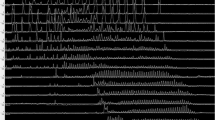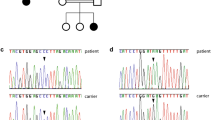Abstract.
The type IV Waardenburg syndrome (WS4), also referred to as Shah-Waardenburg syndrome or Waardenburg-Hirschsprung disease, is characterised by the association of Waardenburg features (WS, depigmentation and deafness) and the absence of enteric ganglia in the distal part of the intestine (Hirschsprung disease). Mutations in the EDN3, EDNRB, and SOX10 genes have been reported in this syndrome. Recently, a new SOX10 mutation was observed in a girl with a neural crest disorder without evidence of depigmentation, but with severe constipation due to a chronic intestinal pseudo-obstruction and persistence of enteric ganglia. To refine the nosology of WS, we studied patients with typical WS4 (including Hirschsprung disease) or with WS and intestinal pseudo-obstruction. We found three SOX10 mutations, one EDNRB and one EDN3 mutations in patients presenting with the classical form of WS4, and two SOX10 mutations in patients displaying chronic intestinal pseudo-obstruction and WS features. These results show that chronic intestinal pseudo-obstruction may be a manifestation associated with WS, and indicate that aganglionosis is not the only mechanism underlying the intestinal dysfunction of patients with SOX10 mutations.
Similar content being viewed by others
Author information
Authors and Affiliations
Additional information
Electronic Publication
Rights and permissions
About this article
Cite this article
Pingault, V., Girard, M., Bondurand, N. et al. SOX10 mutations in chronic intestinal pseudo-obstruction suggest a complex physiopathological mechanism. Hum Genet 111, 198–206 (2002). https://doi.org/10.1007/s00439-002-0765-8
Received:
Accepted:
Published:
Issue Date:
DOI: https://doi.org/10.1007/s00439-002-0765-8




